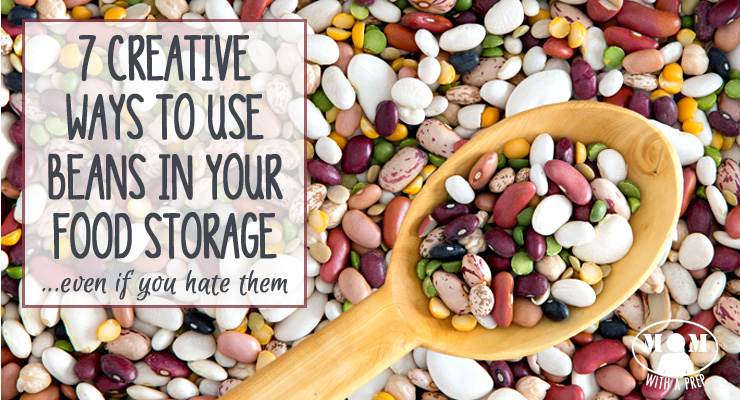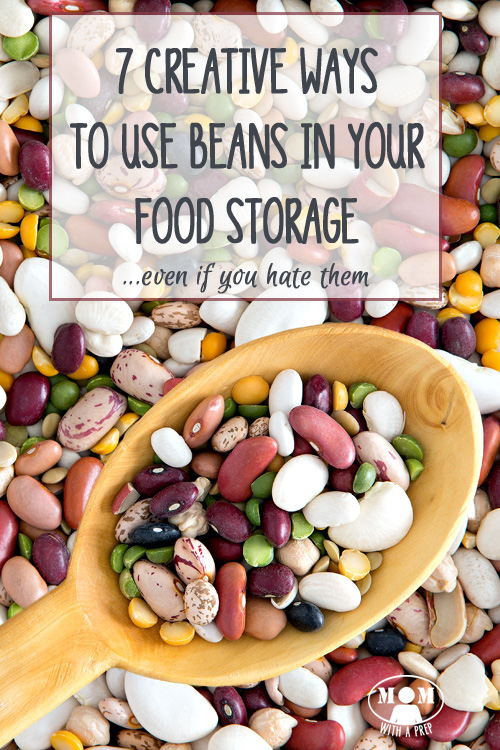
I am no fan of beans. I dislike the texture tremendously, I don’t like the taste of most of them, and I’ve never been able to convince myself that they’re good enough to just get over and eat. I can handle a few in some dishes, but I will tell you a secret. I’m like a two-year-old who hides them in the side of her mouth and just swallows them without chewing. I mean…I really don’t like beans. I don’t hate all beans. But lima beans, pinto beans, and those big white beans – HATE THEM ALL!

However, even I know that beans are really good for you. They provide complex carbohydrates, are nutritionally dense, provide a great source of dietary fiber, and contain a great source of protein, but I also know there’s no point in putting anything into your food storage that you and your family won’t eat. So how do you incorporate beans into your food storage, yet make them useful for something other than weighing down pie crusts and using them for kids’ art projects or science lessons?
The secret is learning how to incorporate beans into your diet in alternative ways!
7 Creative and Easy Ways to Use Food Storage Beans
Using Bean Flours
1. Bean Flours In Baking
Bean flours are used in baking and cooking all over the world. Different beans produce different color flours and consistencies and are readily available at Amazon, Azure Standard, and even your local grocery store now! Bean flours are used by those trying to stay away from gluten for dietary reasons. Here is a great run-down of the different bean flours and how they can be used.
I’ve stuck primarily to garbanzo/chickpea flour because it’s the one bean I stock in my pantry consistently and am familiar with using. I substitute approximately 25% off my all-purpose flour with chickpea flour when doing baked bread to add a bit more protein.
2. Bean Flours in Cooking
Bean flours can be a great way to replace the ‘cream’ in cream of something soup. It is a great way to replace many ‘creamer’ ingredients in popular Meal in a Jar recipes that can extend your food storage with ready-made meals to keep or give as gifts.
Here is the recipe:
- 2 cups stock (this can be chicken, vegetable, or beef stock)
- 1/3 cup white bean flour (you can use chickpea flour or white bean flour)
To make cream of mushroom, choose the beef stock and put in bits of dehydrated mushroom. Alternatively, use vegetable stock with added celery slices for the cream of celery soup. Source: Little House Living
What makes this a great money-saving alternative is that you can grind beans to make your own bean flour!
Bean Dips Recipes
1. Hummus
Hummus is a full-flavored hummus plus crackers, pita bread, crisp vegetable chips or even my spoon is one of my favorite snacks. I love roasted garlic hummus and my youngest one loves lemon hummus (huh?! yeah, that’s what I thought, but the boy who eats so little loves the stuff so I buy it for him as I haven’t found a good recipe to replace his favorite).
It is a middle eastern food staple that sits in my fridge ready-made all the time. I stock up if our grocery store has a big sale and I always have cans of chickpeas and bags of chickpeas in the pantry to make it myself. It is really easy and there are a lot of varieties out there!
Here’s a red lentil hummus that would make a great sandwich spread, too! And I’m dying to try this Peanut Butter Cookie Dough Hummus with apples!
2. Bean Dip
A favorite story from my youth is a friend’s brother who loved bean dip as a child until he found out it was actually made out of beans. Then he refused to eat it ever again. But spicy bean dips can be a great accompaniment to adding flavor to a meal that might otherwise be blah.
This amazing bean dip is not something you can count on to take advantage of food storage during lean times with all the dairy products, it is awesome and versatile to use the leftovers for more! And learning to use your pantry basics now is a great way to rotate your stock and provide healthy meals for your family all the time.
3. Lentil and White Bean Dips
These bean dips can be milder in flavor and still work well as a side dip or as a sandwich spread. White beans give a really creamy texture and have a less distinct flavor profile, so maybe a good choice as a way to begin integrating them into your diet. Try this White Bean Dip and this collection of lentil dips.
Replace Butter and Oil in Baking with Beans
I know, right?! Who knew?! But it’s true.
To replace oil: Use a 1:1 ratio with bean puree. A bean puree is beans with some water enough to make them like applesauce or hummus. You could just dump a can of beans, liquid and all, and blend, but that would be pretty sodium-filled. If you use canned, just dump the liquid, rinse and then replace the liquid with water and go.
To replace butter: Mash the beans instead of pureeing them. You need a little more consistency.
To see more tips on using beans to replace oils and butter in cooking, check out Everyday Food Storage.net’s ideas here.
Thicken Soups with Beans
You can use a bean puree (beans with added water blended) to thicken a soup to make it less watery plus add loads of protein without a ton of added calories. Be careful about the bean you choose overwhelming the flavor of the particular soup you have (you might not want to use pinto beans to flavor a chicken soup). You can also use pre-ground bean flour to accomplish this task.
Bean Sprouts
Now, for those of you who REALLY hate beans, just seeing a bean sprouted may make you turn away because of the fear factor. But don’t. Don’t think of the typical fat legume as being your only source of beans. There is a huge variety and most can be used to sprout and eat on salads or used within recipes. In some cases, sprouting actually makes the bean more digestible and allows some enzymes to be more readily available to your body.
What makes it wonderful is that they’re one of the best foods for you. My sprouting adventures are very limited to just a dish or two, but here is a great resource of sprouting ideas and recipes for you to try. As a side note, please follow sprouting directions to make this a safe way to use beans. Some beans don’t work well and you may introduce contamination if not fully cooked.
Bean Smoothies
Stop. I see you going to click the x to leave this page. But hear me out. Really, you can be adventurous and look to using beans in smoothies to add a big punch of protein without the expensive protein powders (though I have to say – hemp powder is a staple in our house!)
Mixing black beans into a chocolate-based smoothie or cannellini beans into a vanilla-based smoothie will lend a ton of protein without the weird bean taste and make for a healthier smoothie. What about this black bean brownie smoothie or this Pumpkin & White Bean Smoothie? And don’t forget the Asian flair in smoothies with this Green Tea Smoothie.
A photo posted by Mom with a Prep (@jane_momwithaprep) on
A tip: You can broaden what is a standard American list of beans with mung beans, adzuki beans, garbanzo beans/chickpeas, lentils, soybeans, Chinese long beans, and more! Be adventurous!
How Do You Use Food Storage Beans?
Resources:
- I Can’t Believe It’s Food Storage by Crystal Godfrey (great ways on using all types of food storage in new ways)
- Get Started Sprouting
- The Great Vegan Bean Book by Kathy Hester. Not only does this book do a great job of incorporating beans into your meals, but there are also lots of hints and recipes to help you use them in baking, sweets, and more.
- Soaking Secrets to Master the Art of Cooking Beans
Do you have ways you use beans that aren’t a typical way? Please share them with us so that we can all benefit from using our food storage better!

Katy Willis is a writer, lifelong homesteader, and master herbalist, master gardener, and canine nutritionist. Katy is a preparedness expert and modern homesteader practicing everyday preparedness, sustainability, and a holistic lifestyle.
She knows how important it is to be prepared for whatever life throws at you, because you just never know what's coming. And preparedness helps you give your family the best chance to thrive in any situation.
Katy is passionate about living naturally, growing food, keeping livestock, foraging, and making and using herbal remedies. Katy is an experienced herbalist and a member of the CMA (Complementary Medical Association).
Her preparedness skills go beyond just being "ready", she's ready to survive the initial disaster, and thrive afterward, too. She grows 100% organic food on roughly 15 acres and raises goats, chickens, and ducks. She also lovingly tends her orchard, where she grows many different fruit trees. And, because she likes to know exactly what she's feeding her family, she's a seasoned from-scratch cook and gluten-free baker.
Katy teaches foraging and environmental education classes, too, including self-sufficient living, modern homesteading, seed saving, and organic vegetable gardening.
Katy helps others learn forgotten skills, including basic survival skills and self-reliance.
She's been published on sites such as MSN, Angi, Home Advisor, Family Handyman, Wealth of Geeks, Readers Digest, and more.
